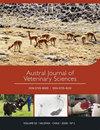Animal models of chronic pain. Are naturally occurring diseases a potential model for translational research?
IF 0.8
4区 农林科学
Q3 VETERINARY SCIENCES
引用次数: 6
Abstract
Despite the vast amount of molecular data obtained from classical pain studies, there is an ongoing translational pain model crisis reflected by the reduced amount of new effective and safe compounds developed to treat chronic pain in humans. Naturally occurring chronic pain in animals may offer some advantages over induced models of chronic pain, including a natural development of the condition that induces pain, the heterogenicity of the population that affects, and the chronologic age in which they develop, among others. The identification and study of naturally occurring painful diseases that resemble a particular chronic painful condition in humans has been proposed as a potential tool to investigate the molecular mechanisms and thus, accelerating drug development at the preclinical and clinical level. Currently, certain types of chronic pain in companion and large animals have gained attention as potential translational models of chronic pain. Examples of these include canine and feline osteoarthritis, neoplastic diseases as osteosarcoma and bovine and equine lameness. The present review describes the limitations of animal models of chronic pain and briefly enters in how naturally occurring pain models could represent a translational approach to chronic pain.慢性疼痛的动物模型。自然发生的疾病是转化研究的潜在模式吗?
尽管从经典疼痛研究中获得了大量的分子数据,但为治疗人类慢性疼痛而开发的新的有效和安全的化合物数量减少,反映了一种持续的转化性疼痛模型危机。动物自然发生的慢性疼痛可能比诱导的慢性疼痛模型有一些优势,包括诱导疼痛的条件的自然发展、影响人群的异质性以及它们发展的时间年龄等。识别和研究类似于人类特定慢性疼痛状况的自然发生的疼痛性疾病,已被认为是研究分子机制的潜在工具,从而加速临床前和临床水平的药物开发。目前,伴侣动物和大型动物的某些类型的慢性疼痛已作为慢性疼痛的潜在转化模型而受到关注。这些疾病的例子包括犬和猫的骨关节炎、骨肉瘤等肿瘤性疾病以及牛和马的跛行。本综述描述了慢性疼痛动物模型的局限性,并简要介绍了自然发生的疼痛模型如何代表慢性疼痛的转化方法。
本文章由计算机程序翻译,如有差异,请以英文原文为准。
求助全文
约1分钟内获得全文
求助全文
来源期刊

Austral Journal of Veterinary Sciences
Veterinary-General Veterinary
CiteScore
1.60
自引率
0.00%
发文量
18
期刊介绍:
Austral Journal of Veterinary Sciences (formerly Archivos de Medicina Veterinaria) publishes original scientific contributions in English, containing the latest developments and discoveries in veterinary sciences. The journal covers topics such as animal health and production, preventive medicine, zoonosis, pharmacology and therapeutics, methods of diagnosis, and other areas related to the veterinary field.
Austral Journal of Veterinary Sciences aims to divulge information about advances in veterinary medicine among universities, research centres, industries, government agencies, biologists, agronomists and veterinarians.
 求助内容:
求助内容: 应助结果提醒方式:
应助结果提醒方式:


